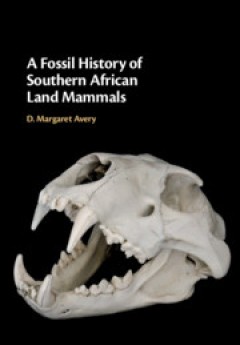Filter by

A Fossil History of Southern African Land Mammals
This reference provides comprehensive information on the taxonomy and distribution in time and space of all currently recognized southern African fossil mammals. After an introductory background chapter on southern Africa, mammals, sites and dating, the following chapters are presented by epoch, covering the Eocene, Miocene, Pliocene, Pleistocene and Holocene. Individual maps provide informatio…
- Edition
- -
- ISBN/ISSN
- 9781108647243
- Collation
- -
- Series Title
- -
- Call Number
- -

The Pangenome = Diversity, Dynamics and Evolution of Genomes
This open access book offers the first comprehensive account of the pan-genome concept and its manifold implications. The realization that the genetic repertoire of a biological species always encompasses more than the genome of each individual is one of the earliest examples of big data in biology that opened biology to the unbounded. The study of genetic variation observed within a species…
- Edition
- 1
- ISBN/ISSN
- 9783030382810
- Collation
- XIV, 307 hlm; ill., lamp.,
- Series Title
- -
- Call Number
- -

Analysis of Reaction-Diffusion Models with the Taxis Mechanism
This open access book deals with a rich variety of taxis-type cross-diffusive equations. Particularly, it intends to show the key role played by quasi-energy inequality in the derivation of some necessary a priori estimates. This book addresses applied mathematics and all researchers interested in mathematical development of reaction-diffusion theory and its application and can be a basis for …
- Edition
- 1
- ISBN/ISSN
- 9789811937637
- Collation
- IX, 411 hlm; ill., lamp.,
- Series Title
- -
- Call Number
- -

Speciesism in Biology and Culture
This open access book explores a wide-ranging discussion about the sociopolitical, cultural, and scientific ramifications of speciesism and world views that derive from it. In this light, it integrates subjects across the natural sciences, social sciences, and humanities. The 21st-century western world is anthropocentric to an extreme; we adopt unreasonably self-centered and self-serving ide…
- Edition
- 1
- ISBN/ISSN
- -
- Collation
- -
- Series Title
- -
- Call Number
- XVI, 203

The Geology of Kuwait
This open access book contains a set of chapters covering all aspects of geosciences related to Kuwait and adjacent regions, including Iran, Saudi Arabia and the Arab Gulf states. It covers basic information about the geology including a wide range of geoscientific disciplines such as marine geology, structural geology, hydrogeology and geophysics related to the region. This book is aimed at re…
- Edition
- 1
- ISBN/ISSN
- 978-3-031-16727-0
- Collation
- -
- Series Title
- Regional Geology Reviews
- Call Number
- XII, 242

Retrograde Evolution During Major Extinction Crises
This book is the first of its kind, providing in-depth analysis of the retrograde evolution occurring during major extinction periods. The text offers a non-strictly adaptative explanation of repetition of phyla after the major extinctions, utilizing a study of seven phylogenetically distinct groups. This opens a new experimental field in evolutionary biology with the possibility of reconstruct…
- Edition
- -
- ISBN/ISSN
- 978-3-319-27917-6
- Collation
- -
- Series Title
- -
- Call Number
- -

Biodiversity of the Gulf of Guinea Oceanic Islands
This open access book presents a comprehensive synthesis of the biodiversity of the oceanic islands of the Gulf of Guinea, a biodiversity hotspot off the west coast of Central Africa. Written by experts, the book compiles data from a plethora of sources – archives, museums, bibliography, official reports and previously unpublished data – to provide readers with the most updated information …
- Edition
- 1
- ISBN/ISSN
- 978-3-031-06153-0
- Collation
- -
- Series Title
- -
- Call Number
- XXV, 694

Sex in Cetaceans
Sex in Cetaceans provides an up-to-date review of multi-faceted aspects related to mating and reproduction in toothed and baleen whales. This open access book begins with discussions of sexual selection and anatomical traits related to mating and diversity between the sexes. The functions of non-conceptive copulations are reviewed as are different research techniques applied to explore sex in c…
- Edition
- -
- ISBN/ISSN
- 978-3-031-35650-6
- Collation
- IX, 619
- Series Title
- -
- Call Number
- -

What If We Don't Die? The Morality of Immortality
This book deals with the very real possibility of earthly immortality and the human and societal implications of such immortality, including whether it is desirable. It looks at what makes immortality appear so attractive and at the possibility that we would be better served with longer lives and the freedom to terminate our lives at the time when life has given us all the joy, inspiration a…
- Edition
- -
- ISBN/ISSN
- 978-3-319-19093-8
- Collation
- -
- Series Title
- -
- Call Number
- -

Vertebrate Myogenesis Stem Cells and Precursors
This book addresses the differentiation control of skeletal muscle in different locations of the vertebrate body Particular attention is paid to novel regulatory molecules and signals as well as the heterogeneity of origin that have revealed a developmental overlap between skeletal and cardiac muscle. Different functional muscle groups are the product of the evolution of the vertebrate classes,…
- Edition
- -
- ISBN/ISSN
- 978-3-662-44608-9
- Collation
- -
- Series Title
- -
- Call Number
- -
 Computer Science, Information & General Works
Computer Science, Information & General Works  Philosophy & Psychology
Philosophy & Psychology  Religion
Religion  Social Sciences
Social Sciences  Language
Language  Pure Science
Pure Science  Applied Sciences
Applied Sciences  Art & Recreation
Art & Recreation  Literature
Literature  History & Geography
History & Geography